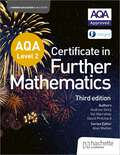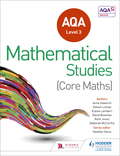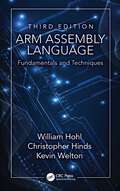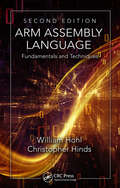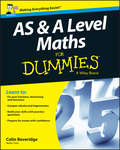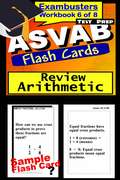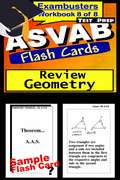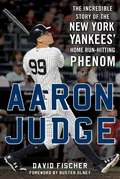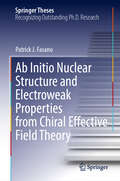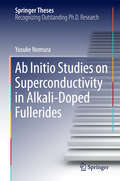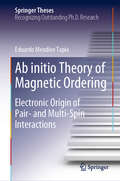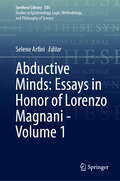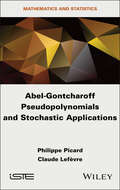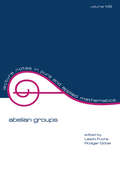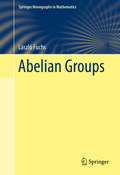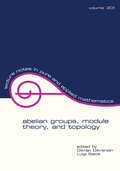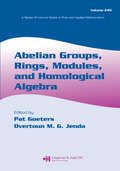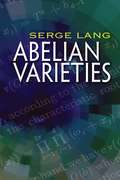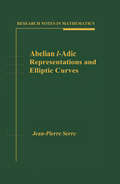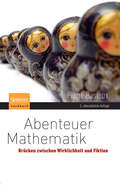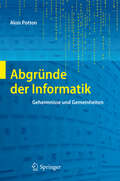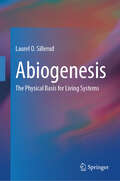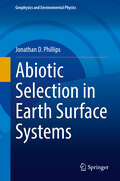- Table View
- List View
AQA Level 2 Certificate in Further Mathematics (3rd edition)
by David Pritchard Val Hanrahan Andrew GintyStretch and challenge students with the 3rd edition of this introduction to higher level mathematics. Plenty of practice activities, worked solutions and exercise questions help students to master the mathematical reasoning skills they need to succeed and prepare for the transition from GCSE to A-level.- Build understanding of mathematics with discussion points, thought-provoking activities and rigorous exercise questions.- Develop problem-solving skills and learn to use mathematical arguments with step-by-step worked examples.- Be mindful of possible misunderstandings; common pitfalls are noted throughout the text.- Check knowledge and understanding with a topic checklist of key points and learning objectives at the end of each chapter.- Embed understanding with free online access to narrated step-by-step examples on the Hachette Learning website.- Helps students to achieve their potential with two practice papers.
AQA Level 3 Certificate in Mathematical Studies
by Heather Davis David Bowman Anne Haworth Steve Lomax Ruth Jones Elaine Lambert Deborah McCarthyMaths but not as you know it; a fresh take that develops problem-solving skills with new and innovative resources that place contemporary contexts at the centre of learning to maximise student potential.- Supports a wide ability range with challenges for all levels.- Provides assessment practice and guidance with practice questions and worked examples to help each student to reach their potential by boosting the skills they need to understand the demands of the new AQA Level 3 Certificate in Mathematical Studies specification.- Saves you time with a variety of new ideas for use in the classroom and at home.- Places mathematical problems into real life contexts helping your students to apply their knowledge across subjects.- Supports the non-specialist or less-confident teacher.
ARM Assembly Language: Fundamentals and Techniques
by William Hohl Christopher Hinds Kevin WeltonARM Assembly Language: Fundamentals and Techniques, Third Edition explains in clear terms how ARM processors are programmed at the most fundamental level. While earlier editions covered much older architectures, the Third Edition moves entirely into the Cortex-M space, using the Armv8-M instruction set to illustrate how assembly code for the most modern Arm processors is written. Even if you are writing in JavaScript, Python, C++, C#, or Rust, these high-level programming languages require a compiler or interpreter to transform the code into machine-executable instructions, so software and hardware engineers will gain valuable insight into how their code is executing from knowing how the underlying processor functions.Featuring chapters updated to Armv8-M throughout this book, this edition: Moves all examples into the Keil MDK environment, which uses armclang and a GNU-like syntax that is very popular in the industry Includes an appendix that helps students set up the Keil tools for use throughout this book Describes the IEEE 754 floating-point arithmetic supported by the Armv8-M processors implementing the optional Floating-Point Unit (FPU) Features an updated chapter on mixing C and assembly code together Discusses features and concepts found in the most advanced Arm processors, such as the Cortex-A and Cortex-X families using Armv9 architectures Written by authors who each have more than 35 years of experience in the semiconductor industry, ARM Assembly Language: Fundamentals and Techniques, Third Edition makes an ideal textbook for students wanting to learn about microprocessors but who may possess only a basic knowledge of programming and logic.
ARM Assembly Language: Fundamentals and Techniques, Second Edition
by William Hohl Christopher HindsDelivering a solid introduction to assembly language and embedded systems, ARM Assembly Language: Fundamentals and Techniques, Second Edition continues to support the popular ARM7TDMI, but also addresses the latest architectures from ARM, including Cortex�-A, Cortex-R, and Cortex-M processors-all of which have slightly different instruction sets, p
AS and A Level Maths For Dummies
by Colin BeveridgePass your AS & A level maths with flying colours Looking to pass your AS and A level maths? Look no further. AS & A Level Maths For Dummies offers detailed, simple steps for all of the main types of problems you'll face in your exams, offering explanations of how the topics link together, advice on how to remember the key facts and methods, and ways to structure revision. Even if your head is spinning and you don't know where to begin, this fun and friendly guide gives in-depth support on exactly what you need to know. In the big data and digital age, maths skills have never been more important to career success. AS & A Level Maths For Dummies guides you through the skills needed to pass the exams taken at the end of the first and second year of the course. It begins with the knowledge needed to get a top grade at GCSE, followed by sections on Algebra (functions, graph-sketching, and logarithms), Geometry (coordinate geometry, trigonometry, and working with shapes) and Calculus (differentiation, integration, and differential equations). Helps you build the confidence you need to pass your exams Serves as an excellent supplement to classroom learning Makes difficult maths concepts easy to understand Offers in-depth support in a fun and friendly style If you're an AS & A level student looking to do your very best at exam time, AS & A Level Maths For Dummies makes it easier.
ASVAB Test Prep Flash Cards: Algebra (Exambusters ASVAB Workbook #7 of 8)
by Ace Inc.<P><P><i>Advisory: Bookshare has learned that this book offers only partial accessibility. We have kept it in the collection because it is useful for some of our members. Benetech is actively working on projects to improve accessibility issues such as these.</i><P><P> "ASVAB Prep Flashcard Workbook 7: ALGEBRA REVIEW" 450 questions and answers that highlight introductory algebra definitions, problems, and concepts. Topics: Algebraic Concepts, Sets, Variables, Exponents, Properties of Numbers, Simple Equations, Signed Numbers, Monomials, Polynomials, Additive and Multiplicative Inverse, Word Problems, Prime Numbers, Factoring, Algebraic Fractions, Ratio and Proportion, Variation, Radicals, Quadratic Equations <P>EXAMBUSTERS ASVAB Prep Workbooks provide comprehensive, fundamental ASVAB review--one fact at a time--to prepare students to take practice ASVAB tests. Each ASVAB study guide focuses on one specific subject area covered on the ASVAB exam. From 300 to 600 questions and answers, each volume in the ASVAB series is a quick and easy, focused read. Reviewing ASVAB flash cards is the first step toward more confident ASVAB preparation and ultimately, higher ASVAB exam scores!
ASVAB Test Prep Flash Cards: Arithmetic (Exambusters ASVAB Workbook #6 of 8)
by Ace Inc.<P><P><i>Advisory: Bookshare has learned that this book offers only partial accessibility. We have kept it in the collection because it is useful for some of our members. Benetech is actively working on projects to improve accessibility issues such as these.</i><P><P> "ASVAB Prep Flashcard Workbook 6: ARITHMETIC REVIEW" 600 questions and answers highlight essential arithmetic definitions, problems, and concepts. Topics: Addition, Subtraction, Multiplication, and Division of Whole Numbers; Fractions and Decimals, Multiplication Tables, Word Problems, Percents, Measurement, Metric System, Square Roots and Powers, Real Numbers, Properties of Numbers <P>EXAMBUSTERS ASVAB Prep Workbooks provide comprehensive, fundamental ASVAB review--one fact at a time--to prepare students to take practice ASVAB tests. Each ASVAB study guide focuses on one specific subject area covered on the ASVAB exam. From 300 to 600 questions and answers, each volume in the ASVAB series is a quick and easy, focused read. Reviewing ASVAB flash cards is the first step toward more confident ASVAB preparation and ultimately, higher ASVAB exam scores!
ASVAB Test Prep Flash Cards: Geometry (Exambusters ASVAB Workbook #8 of 8)
by Ace Inc.<P><P><i>Advisory: Bookshare has learned that this book offers only partial accessibility. We have kept it in the collection because it is useful for some of our members. Benetech is actively working on projects to improve accessibility issues such as these.</i><P><P> "ASVAB Prep Flashcard Workbook 8: GEOMETRY" 450 questions and answers (ILLUSTRATED) that focus on essential geometry theorems, postulates, concepts, and definitions. Includes complementary diagrams. Topics: Lines and Angles, Triangles, Proofs, Perpendicular Lines, Parallel Lines, Angle Sums, Quadrilaterals, Medians, Altitudes and Bisectors, Circles, Ratio and Proportion, Similar Polygons, Circles and Regular Polygons, Coordinate Geometry <P>EXAMBUSTERS ASVAB Prep Workbooks provide comprehensive, fundamental ASVAB review--one fact at a time--to prepare students to take practice ASVAB tests. Each ASVAB study guide focuses on one specific subject area covered on the ASVAB exam. From 300 to 600 questions and answers, each volume in the ASVAB series is a quick and easy, focused read. Reviewing ASVAB flash cards is the first step toward more confident ASVAB preparation and ultimately, higher ASVAB exam scores!
Aaron Judge: The Incredible Story of the New York Yankees' Home Run–Hitting Phenom
by Buster Olney David FischerAt 6-foot-7 and 285 pounds, Aaron Judge emerged as the biggest story in baseball in 2017 with his monstrous home runs and record-breaking ability. A three-sport athlete in high school and a Division I ballplayer at Fresno State, the Californian was drafted by the New York Yankees in the first round in 2013 and made it to the majors by August 2016. Homering in his first major league at-bat and starting in right field straight out of spring training in 2017, he gave Yankees fans hope for the future, along with "Baby Bombers" teammates such as Gary Sanchez.After a rough start in which he batted below .200 and struck out in over 40 percent of his plate appearances after joining the Yankees, Judge turned things around and helped get his team off to a fast start in 2017 with 10 homers in April alone, tying the rookie record for the month. He then broke the legendary Joe DiMaggio’s team record for most round trippers by the All-Star break with 30, including one that measured at 495 feet. His mounting popularity enabled him to receive more All-Star votes than any American League player and to the creation of the "Judge's Chambers" section located in the right-field stands of Yankee Stadium. Judge's momentum next led to him winning the 2017 Home Run Derby where he smashed a total of 47, four of which traveled more than 500 feet. It's no wonder that baseball commissioner Rob Manfred has said that Judge is a player "who can become the face of the game." In Aaron Judge: The Incredible Story of the New York Yankees' Home Run-Hitting Phenom, David Fischer brings the exciting story of the Yankees' newest superstar to life.
Ab Initio Nuclear Structure and Electroweak Properties from Chiral Effective Field Theory (Springer Theses)
by Patrick J. FasanoThis thesis presents a consistent application of chiral effective field theory (EFT) interactions and currents to obtain ab initio results for light nuclei magnetic dipole and Gamow-Teller strengths in light nuclei (A≤17). Recent results have demonstrated the importance of chiral EFT corrections for correctly predicting magnetic dipole and Gamow-Teller strengths in nuclei. However, these studies have not consistently applied the same treatment to these operators as is applied to the interaction. In this work, it is found that the inclusion of chiral EFT corrections to the magnetic dipole and Gamow-Teller operators generally brings the calculated results closer to agreement with experiment. However, this work also demonstrates that the convergence of the solution to the many-body problem still poses substantial difficulties. This work has confirmed that the inclusion of chiral EFT corrections is necessary to describe light nuclei, while concluding that higher-order corrections are necessary in order to obtain good agreement with experimental data.
Ab Initio Studies on Superconductivity in Alkali-Doped Fullerides (Springer Theses)
by Yusuke NomuraThis book covers high-transition temperature (Tc) s-wave superconductivity and the neighboring Mott insulating phase in alkali-doped fullerides. The author presents (1) a unified theoretical description of the phase diagram and (2) a nonempirical calculation of Tc. For these purposes, the author employs an extension of the DFT+DMFT (density-functional theory + dynamical mean-field theory). He constructs a realistic electron-phonon-coupled Hamiltonian with a newly formulated downfolding method. The Hamiltonian is analyzed by means of the extended DMFT. A notable aspect of the approach is that it requires only the crystal structure as a priori knowledge. Remarkably, the nonempirical calculation achieves for the first time a quantitative reproduction of the experimental phase diagram including the superconductivity and the Mott phase. The calculated Tc agrees well with the experimental data, with the difference within 10 K. The book provides details of the computational scheme, which can also be applied to other superconductors and other phonon-related topics. The author clearly describes a superconducting mechanism where the Coulomb and electron-phonon interactions show an unusual cooperation in the superconductivity thanks to the Jahn-Teller nature of the phonons.
Ab initio Theory of Magnetic Ordering: Electronic Origin of Pair- and Multi-Spin Interactions (Springer Theses)
by Eduardo Mendive TapiaMany technological applications exploit a variety of magnetic structures, or magnetic phases, to produce and optimise solid-state functionality. However, most research advances are restricted to a reduced number of phases owing to computational and resource constraints. This thesis presents an ab-initio theory to efficiently describe complex magnetic phases and their temperature-dependent properties. The central assumption is that magnetic phases evolve slowly compared with the underlying electronic structure from which they emerge. By describing how the electronic structure adapts to the type and extent of magnetic order, a theory able to describe multi-spin correlations and their effect on the magnetism at finite temperature is obtained. It is shown that multi-spin correlations are behind the temperature and magnetic field dependence of the diverse magnetism in the heavy rare earth elements. Magnetically frustrated Mn-based materials and the effect of strain are also investigated. These studies demonstrate that the performance of solid-state refrigeration can be enhanced by multi-spin effects.
Abacus Basic Competency: A Counting Method
by Susan M. MillawayLearn the parts of an abacus, how to "set" numbers and how to do calculations! There are competency tests with answers in the back of the book.
Abductive Minds: Essays in Honor of Lorenzo Magnani - Volume 1 (Synthese Library #505)
by Selene ArfiniThis book, the first of two volumes, provides novel perspectives on the study of abduction, by analyzing both Magnani’s ample investigation of the subject and discussing its rising importance in today’s epistemology and philosophy of science. Notwithstanding the long history of the concept, which has been studied since its analysis in Aristotle’s Organon, in the last fifty years, it has known a resurgent interest in the epistemological literature since it is an ampliative inference deemed to be at the core of creative leaps and acts of discovery. For these reasons, different open questions still bother interested researchers: which constraints affect abductive reasoning when a hypothesis is evaluated or selected? Should we adopt a unified view on abduction or maintain a pluralistic perspective regarding its forms and functions? What kinds of models can be used in abductive reasoning? This last question, in particular, shows how the topics of the two parts of the volume are intrinsically connected and ensures they are of great importance to those interested in epistemology, philosophy of science, mathematical logic and AI.
Abel-Gontcharoff Pseudopolynomials and Stochastic Applications (ISTE Invoiced)
by Claude Lefevre Philippe PicardThis book proposes a new mathematical methodology for addressing first passage problems, particularly in various classical stochastic models of applied probability. This approach is based on the so-called Abel-Gontcharoff (A-G) pseudopolynomials and the associated A-G expansions, which have been introduced and studied by the authors in recent years. These A-G expansions generalize the well-known Abel expansion, which allows us to extend the standard Taylor formula. Abel-Gontcharoff Pseudopolynomials and Stochastic Applications starts by presenting an in-depth presentation of the general theory, and then moves onto stochastic applications of this theory, especially in biomathematics. Univariate and multivariate versions of the A-G pseudopolynomials, as well as extensions with randomized parameters, are discussed and illustrated for modeling, notably by highlighting families of martingales and using stopping time theorems. This book concludes by paving the way to a nonhomogeneous theory for first crossing problems.
Abelian Groups
by Laszlo Fuchs Rüdiger GöbelThis volume contains information offered at the international conference held in Curacao, Netherlands Antilles. It presents the latest developments in the most active areas of abelian groups, particularly in torsion-free abelian groups.;For both researchers and graduate students, it reflects the current status of abelian group theory.;Abelian Groups discusses: finite rank Butler groups; almost completely decomposable groups; Butler groups of infinite rank; equivalence theorems for torsion-free groups; cotorsion groups; endomorphism algebras; and interactions of set theory and abelian groups.;This volume contains contributions from international experts. It is aimed at algebraists and logicians, research mathematicians, and advanced graduate students in these disciplines.
Abelian Groups (Springer Monographs in Mathematics)
by László FuchsWritten by one of the subject's foremost experts, this book focuses on the central developments and modern methods of the advanced theory of abelian groups, while remaining accessible, as an introduction and reference, to the non-specialist. It provides a coherent source for results scattered throughout the research literature with lots of new proofs. The presentation highlights major trends that have radically changed the modern character of the subject, in particular, the use of homological methods in the structure theory of various classes of abelian groups, and the use of advanced set-theoretical methods in the study of un decidability problems. The treatment of the latter trend includes Shelah's seminal work on the un decidability in ZFC of Whitehead's Problem; while the treatment of the former trend includes an extensive (but non-exhaustive) study of p-groups, torsion-free groups, mixed groups and important classes of groups arising from ring theory. To prepare the reader to tackle these topics, the book reviews the fundamentals of abelian group theory and provides some background material from category theory, set theory, topology and homological algebra. An abundance of exercises are included to test the reader's comprehension, and to explore noteworthy extensions and related sidelines of the main topics. A list of open problems and questions, in each chapter, invite the reader to take an active part in the subject's further development.
Abelian Groups, Module Theory, and Topology: Proceedings In Honor Of Adalberto Orsatti's 60th Birthday (Lecture Notes in Pure and Applied Mathematics #Vol. 201)
by Dikran Dikranjan Luigi SalceFeatures a stimulating selection of papers on abelian groups, commutative and noncommutative rings and their modules, and topological groups. Investigates currently popular topics such as Butler groups and almost completely decomposable groups.
Abelian Groups, Rings, Modules, and Homological Algebra (Lecture Notes in Pure and Applied Mathematics)
by Pat Goeters Overtoun M. G. JendaAbout the bookIn honor of Edgar Enochs and his venerable contributions to a broad range of topics in Algebra, top researchers from around the world gathered at Auburn University to report on their latest work and exchange ideas on some of today's foremost research topics. This carefully edited volume presents the refereed papers of the par
Abelian Varieties (Dover Books on Mathematics)
by Serge LangBased on the work in algebraic geometry by Norwegian mathematician Niels Henrik Abel (1802–29), this monograph was originally published in 1959 and reprinted later in author Serge Lang's career without revision. The treatment remains a basic advanced text in its field, suitable for advanced undergraduates and graduate students in mathematics. Prerequisites include some background in elementary qualitative algebraic geometry and the elementary theory of algebraic groups.The book focuses exclusively on Abelian varieties rather than the broader field of algebraic groups; therefore, the first chapter presents all the general results on algebraic groups relevant to this treatment. Each chapter begins with a brief introduction and concludes with a historical and bibliographical note. Topics include general theorems on Abelian varieties, the theorem of the square, divisor classes on an Abelian variety, functorial formulas, the Picard variety of an arbitrary variety, the I-adic representations, and algebraic systems of Abelian varieties. The text concludes with a helpful Appendix covering the composition of correspondences.
Abelian l-Adic Representations and Elliptic Curves (Research Notes in Mathematics)
by Jean-Pierre SerreThis classic book contains an introduction to systems of l-adic representations, a topic of great importance in number theory and algebraic geometry, as reflected by the spectacular recent developments on the Taniyama-Weil conjecture and Fermat's Last Theorem. The initial chapters are devoted to the Abelian case (complex multiplication), where one
Abenteuer Mathematik: Brücken zwischen Wirklichkeit und Fiktion
by Pierre BasieuxNicht Mathematik zu betreiben, sondern zu erfahren ist das Abenteuer, das dieses Buch bietet - Denkexpeditionen, deren Ausgangspunkt Fragen sind: Was steckt hinter mathematischen Fiktionen wie den unendlich vielen Stufen des Unendlichen oder dem Letzten Fermatschen Satz? Worin liegt ihre Schönheit, worin ihr Bezug zur Realität? Welchen Köpfen sind solche Ideen entsprungen, welche Schicksale mit ihnen verbunden? Das Buch wurde für die vorliegende 5. Auflage vollständig durchgesehen und aktualisiert.
Abgründe der Informatik: Geheimnisse und Gemeinheiten
by Alois PottonWas Sie schon immer über die Informatik und "die Informatiker" wissen wollten, aber nie zu fragen wagten, Alois Potton hat es notiert: Über mehr als zwei Jahrzehnte hat er hinter die Kulissen geblickt und Anekdoten in 80 Glossen gegossen. Schonungslos, bösartig und zum Teil politisch nicht ganz korrekt analysiert er den alltäglichen Wahnsinn und die Absurditäten der IT-Szene. Allgemein verständlich geschrieben, werden sich auch Nichtinformatiker angesichts analoger Vorgänge in ihrem Arbeitsbereich amüsieren - oder aber beleidigt fühlen.
Abiogenesis: The Physical Basis for Living Systems
by Laurel O. SillerudThis textbook serves to teach readers about the origins of life, the probabilistic process of self-assembly underpinning all living systems, from a biophysics perspective. The author cohesively summarizes the various organizing principles that led to the development of an ordered physical basis on which the evolution of life operates. This book answers critical questions, such as why life depends on the properties of inanimate objects and how the laws of physics, chemistry, and biology convolved to spontaneously produce the periodic table and, of course, life itself. Readers are provided with an introduction to probability distributions as well as detailed descriptions of important concepts in thermodynamics, statistical mechanics, and quantum mechanics. As the book progresses, an understanding for the inevitability of life is developed through topics such as stellar nucleosynthesis and prebiotic evolution. Each chapter also includes problems for readers to gain a better understanding of the material. This textbook is accessible to students and researchers of all levels and serves as a comprehensive guide on the physics behind abiogenesis.
Abiotic Selection in Earth Surface Systems (Geophysics and Environmental Physics)
by Jonathan D. PhillipsThis book is about abiotic selection in Earth surface systems. It demonstrates that seemingly purposeful or goal-oriented phenomena in Earth's processes actually emerge from selection dynamics. While many think of selection in the context of biological evolution, it extends to abiotic processes crucial in understanding Earth's function and evolution. The author delineates four forms of geophysical selection: gradient, resistance, network, and thermodynamic. These selections manifest in various natural systems, from fluid flows shaping landscapes to the efficient transport of mass and energy. The book acknowledges the interplay of geophysical and ecological processes, employing them as pedagogical tools. Structured with an introduction to abiotic selection and its context, the book delves into the application of key principles—such as thermodynamics and flow dynamics—to Earth surface systems. Each subsequent chapter examines one of the four types of selection, featuring diverse real-world examples from climate dynamics to oceanography. Geared toward researchers, graduate students, and practitioners in fields such as geophysics, geology, geography, hydrology, and ecosystem sciences, it also appeals to those interested in evolutionary thinking beyond traditional life sciences.
